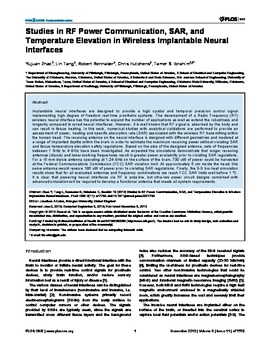| dc.contributor.author | Yujuan Zhao | en_US |
| dc.contributor.author | Lin Tang | en_US |
| dc.contributor.author | Robert Rennaker | en_US |
| dc.contributor.author | Chris Hutchens | en_US |
| dc.contributor.author | Tamer S. Ibrahim | en_US |
| dc.date.accessioned | 2015-01-23T17:17:48Z | |
| dc.date.accessioned | 2016-03-30T15:36:06Z | |
| dc.date.available | 2015-01-23T17:17:48Z | |
| dc.date.available | 2016-03-30T15:36:06Z | |
| dc.date.issued | 2013-11-06 | en_US |
| dc.identifier.citation | Zhao Y, Tang L, Rennaker R, Hutchens C, Ibrahim TS (2013) Studies in RF Power Communication, SAR, and Temperature Elevation in Wireless Implantable Neural Interfaces. PLoS ONE 8(11): e77759. doi:10.1371/journal.pone.0077759 | en_US |
| dc.identifier.uri | https://hdl.handle.net/11244/14100 | |
| dc.description | | en_US |
| dc.description | Conceived and designed the experiments: TI RR CH. Performed the experiments: YZ LT. Analyzed the data: TI YZ LT. Wrote the manuscript: TI YZ LT RR. | en_US |
| dc.description.abstract | Implantable neural interfaces are designed to provide a high spatial and temporal precision control signal implementing high degree of freedom real-time prosthetic systems. The development of a Radio Frequency (RF) wireless neural interface has the potential to expand the number of applications as well as extend the robustness and longevity compared to wired neural interfaces. However, it is well known that RF signal is absorbed by the body and can result in tissue heating. In this work, numerical studies with analytical validations are performed to provide an assessment of power, heating and specific absorption rate (SAR) associated with the wireless RF transmitting within the human head. The receiving antenna on the neural interface is designed with different geometries and modeled at a range of implanted depths within the brain in order to estimate the maximum receiving power without violating SAR and tissue temperature elevation safety regulations. Based on the size of the designed antenna, sets of frequencies between 1 GHz to 4 GHz have been investigated. As expected the simulations demonstrate that longer receiving antennas (dipole) and lower working frequencies result in greater power availability prior to violating SAR regulations. For a 15 mm dipole antenna operating at 1.24 GHz on the surface of the brain, 730 uW of power could be harvested at the Federal Communications Commission (FCC) SAR violation limit. At approximately 5 cm inside the head, this same antenna would receive 190 uW of power prior to violating SAR regulations. Finally, the 3-D bio-heat simulation results show that for all evaluated antennas and frequency combinations we reach FCC SAR limits well before 1 °C. It is clear that powering neural interfaces via RF is possible, but ultra-low power circuit designs combined with advanced simulation will be required to develop a functional antenna that meets all system requirements. | en_US |
| dc.language.iso | en_US | en_US |
| dc.publisher | PLos One | en_US |
| dc.relation.ispartofseries | PLoS ONE 8(11):e77759 | en_US |
| dc.relation.uri | http://www.plosone.org/article/info%3Adoi%2F10.1371%2Fjournal.pone.0077759 | en_US |
| dc.rights | Attribution 3.0 United States | en_US |
| dc.rights.uri | https://creativecommons.org/licenses/by/3.0/us/ | en_US |
| dc.subject | PLOS | en_US |
| dc.subject | Public Library of Science | en_US |
| dc.subject | Open Access | en_US |
| dc.subject | Open-Access | en_US |
| dc.subject | Science | en_US |
| dc.subject | Medicine | en_US |
| dc.subject | Biology | en_US |
| dc.subject | Research | en_US |
| dc.subject | Peer-review | en_US |
| dc.subject | Inclusive | en_US |
| dc.subject | Interdisciplinary | en_US |
| dc.subject | Ante-disciplinary | en_US |
| dc.subject | Physics | en_US |
| dc.subject | Chemistry | en_US |
| dc.subject | Engineering | en_US |
| dc.title | Studies in RF Power Communication, SAR, and Temperature Elevation in Wireless Implantable Neural Interfaces | en_US |
| dc.type | Research Article | en_US |
| dc.description.peerreview | Yes | en_US |
| dc.description.peerreviewnotes | http://www.plosone.org/static/editorial#peer | en_US |
| dc.identifier.doi | 10.1371/journal.pone.0077759 | en_US |
| dc.rights.requestable | false | en_US |

